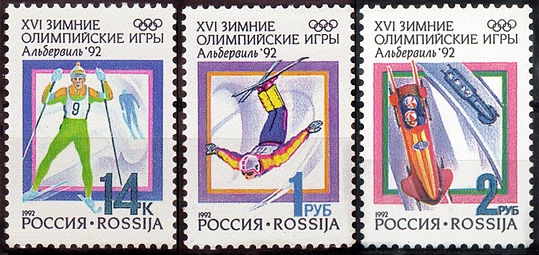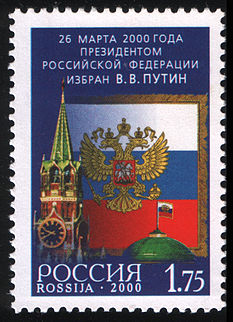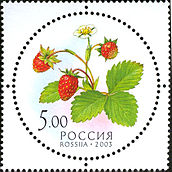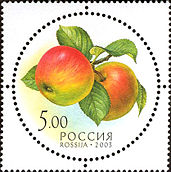User:Michael Romanov/sandbox
Headline text
[edit]Postal history of Russia
[edit]

Early history
[edit]Records mention a system of messengers in the 10th century. Early letters were carried in the form of a roll, with a wax or lead seal; the earliest known of these seals dates from 1079, and mentions a governor Ratibor of Tmutarakan.[1]
The earliest surviving cover was sent in 1391 from La Tana (now Azov) to Venice.[1][2]
By the 16th century, the postal system included 1,600 locations, and mail took 3 days to travel from Moscow to Novgorod. In 1634, a peace treaty between Russia and Poland established a route to Warsaw, becoming Russia's first regular international service.[1][2]
Russian Empire
[edit]

Peter the Great enacted reforms making the postal system more uniform in its operations, and in 1714 the first general post offices opened in Saint Petersburg and Moscow.[1][2] “Regular post service” was established along the Moscow and Riga routes. In February 1714, the postal service started biweekly runs from St. Petersburg to Riga; in June it started runs from St. Petersburg to Moscow. The field post office was founded in 1716, and the so-called ordinary post service in 1720, for fast conveyance of state ordinances and papers. Regular delivery of private parcels (the so-called heavy post) was organized in the 1730–40s. In 1746, parcels and private correspondence were first delivered by courier, and starting in 1781 money, too, could be delivered to one's door.
The earliest known Russian postmark dates from July 1765; it is a single line reading "ST.PETERSBOVRG" (in Latin letters), but the first official recommendation to use postmarks did not come until 1781.[1][2]

Post coaches appeared in 1820. In 1833, the St. Petersburg City Post was created, and the city was divided into 17 districts with 42 correspondence offices, which were located in trade stores. In 1834, reception offices appeared in the suburbs (in St. Petersburg there were as many as 108). Periodical press delivery in Russia was organized in St. Petersburg in 1838. The Department of Coaches and T-carts was opened in 1840 at the Moika Embankment; light cabriolets carried surplus-post, coaches delivered light post, and T-carts dealt with “heavy" post. Green coloured street mail boxes were installed in 1848, the same year stamped envelopes were issued; orange mailboxes for same day service appeared near railway stations in 1851, and post stamps appeared in 1857. In 1864, the City Post started sending printed matter and catalogues, and in 1866, they sent packages.
Postal stationery made its first appearance in 1845, in the form of envelopes that paid the 5-kopeck fee for local mail in St. Petersburg and Moscow. The idea worked well, and was extended throughout Russia on December 1, 1848.[1][2]
Local postal systems used stamps referred to as Zemstvo stamps, from the term for local government, begun under Alexander II in 1864.[3] The Zemstvo post system was officially organised by an Imperial decree of 27 August 1870.[4]
Russian Post is a founding member of the Universal Postal Union created in 1874.[4][2]
In 1902, Chief Postal Service was made part of the Internal Affairs Ministry and in 1917 under the Provisional Government it became Ministry of Posts and Telegraphs. After the October Revolution, the People's Commissariat for Posts and Telegraphs of the RSFSR was formed.
Soviet Union
[edit]During the Great Patriotic War, Soviet postal service was a part of the People's Commissariat for Communications of the USSR. It delivered up to 70 million parcels per month to the Soviet Army front from the rear under extremely difficult and often very dangerous conditions.
In the postwar years, mail service has undergone quantitative and qualitative changes. In 1946, the People's Commissariat for Communications of the USSR was transformed into the Ministry of Communications of the USSR. Postal service has been carried out by the Post Office, which was part of the Ministry of Communications, along with other offices of telecommunications industries. By 1950, the post industry, destroyed by the war, was restored and brought to the pre-war level.
In subsequent years, significantly expanded network of communication enterprises, especially in rural areas. In the cities and a network of liaison offices, post offices and subordinate communication centers. Most businesses became combine the post, telegraph and telephone. These communications are typically located in the same building and under single management. A huge network was established of mailboxes was that were installed not only in cities but also in rural areas, stations, railway sidings, at the forks of freeways.
Further development of the postal service followed the path of mechanization and automation of mail processing, improving the organization of its transportation and delivery. For this the old postal equipment was modernized and developing the production of its brand new designs - mail processing and handling machines and equipment for container transport, means of mechanization and post inventory, as well as equipment for customer service.
Leningrad post office
[edit]By the late 1930s, 203 post offices operated in Leningrad. During the Great Patriotic War of 1941-45, communication between the front line and the rear was provided by the Field Post. In the first year of the Siege, there were 108 post offices working in Leningrad. The Leningrad Post Association was created in 1988, and included the General Leningrad Post-Office, 13 regional post offices, 345 post offices, 11 automatized post offices, and a fleet of cars.
Russian Federation
[edit]In 1993 Russian Post became a part of Ministry of Communications. In 1995, the Office was reorganized into the Federal Service of the Russian Federation postal service, and in 1996 it was reorganized into the Department of Post in the Ministry of Communications of the Russian Federation. Russian postal enterprises were operating and commercial independence, but with it the strong competition posed by former partners Telecommunication companies. Thus, despite the separation of industries, a unique postal network, established in prior periods and covering almost all localities in the country, has been preserved.
Given the role of the Russian post in the historical development of the state, in 1994, Russian President Boris Yeltsin established the professional holiday of postal workers - "Day of the Russian Post", which is celebrated annually on the second July 2. Another presidential decree in 1997 restored the heraldic traditions of Russian Post with the adding of the emblem and flag.
Loss of monopoly
[edit]In 1996, the Ministry of Communications for the first time decided to violate the state postal monopoly on some postal services, resulting in Russia have commercial mailing companies.
2002 reform
[edit]Since the soviet union dissolved, the Federal Postal Service consisted of a network of 90 disparate entities which were mainly listed as state institutions or federal state unitary enterprises. In legal terms, they were completely independent concerns. They were linked to the Federal Postal Network only by a trunk intrazonal and inter-district transmission and delivery system. The most ridiculous part of the whole system was that different parts of the same system connected by a single mechanism in adjacent regions were competing against each other, which mainly involved trying to lure big corporate clients away from the other competitors often at dumping prices. Also there were no uniform budgeting, planning or other processes. These companies operated using outdated and worn-out postal facilities representing about 50 different IT solutions in terms of industry technology. In accordance with the concept of restructuring the federal postal service, adopted by the Government Decree on 28 June 2002, the postal industry in the Russian Federation carried out the reorganization, aimed at creating a single, highly efficient and competitive company able to make a significant contribution to the solution of urgent problems on the accelerated development of the economy and resulted in the establishment of a single unified operator- Federal Unitary Enterprise Russian Post. By 2005 the reform was completed.
Post-reform period
[edit]In 2004 Elsag Datamat won the tender to build Russian Post’s first automated sorting center.[5] In 2008, Andrey Kazmin, former CEO of Sberbank was appointed to the CEO of the company.[6]
Although in January 2009 it was announced that Kazmin had to leave his post as CEO of the Russian Post.[7] Current General Director is Aleksandr Kiselyov.
Growing inefficiency in the 2010s
[edit]The early 2010s saw a rise in complaints. The number of parcels from foreign online retailers had been rising steadily for several years and was certain to rise further.[8] According to Russian Post’s own estimates, orders from Internet shops are delivered to Russia mostly in ordinary or registered parcels; in 2009 there were 2.3 million, in 2012 the amount soared to 17 million. On March 6, 2012, five trucks from Germany were in queue to be unloaded at Vnukovo International Airport. At the International Post Office there had piled up 12,300 parcels, 5,300 EMS packages, and 36,000 minor incoming parcels. And two thousand parcels were waiting for customs clearance at Sheremetyevo International Airport.[9]
2012 saw the creating of a new resource called "anti-Russianpost.ru" emerged in the world web. The users highlight all instances of Russian Post’s bad work. In the middle of March the clients of on-line retailers launched a massive spam attack on the Moscow office of the Roskomnadzor watchdog. In this period the company received up to 1,000 messages from individuals with complaints about delayed deliveries of purchases made at Internet shops.
2013 collapse and reform
[edit]On March 2013 Russian Post reported the unfavorable state of affairs to the authorities of higher instance. In a special message Russian Post’s deputy general director, Nina Fetisova, told the Federal Communications Agency Rossvyaz and the Federal Customs Service the processing of international mail was in a critical situation at the customs posts Vnukovo and Sheremetyevo International Airport and also at the Central International Post Office in Moscow. The director of the federal postal services of the Vologda Oblast said "The reason for delays is not our own ineffectiveness, but the pressure of social factors. We have too many official functions: the delivery of pensions, of written correspondence, and the subscription to newspapers and magazines".
In order to improve the services, Prime Minister Dmitry Medvedev signed a Government Resolution to take the Russian Post out of the sphere of competence of the Federal Communications Agency Rossvyaz, and subordinated it directly to the Ministry of Communications and Mass Media.[9][10] Also, On April of that year, the General Director of the Post, Alexander Kiselyov was ousted from the office.[11]
The company's new management, in October 2013, stated an ambitious goal of doubling revenues to make the company ready for an initial public offering in 2018 by allowing it to provide banking services, reducing the number of unprofitable branches and focusing on providing deliveries from online retailers.[12]
In order to handle the growth of parcels, production capacity has been expanded regional seats of international postal exchange centers, with the company opening new international mail processing centers in Moscow at the Kazan station and in Yekaterinburg and Novosibirsk. In addition, Russian Post agreed with foreign postal operators sorting international mail delivery by region even in the country of the sender (pre-sorting began in China, the largest importer), which allows to reduce the delivery of international mail. For example, after opening Exchange center in Yekaterinburg, parcel from China to residents of the Sverdlovsk Oblast is delivered in five days, including all customs clearance.[13]
On August 2013 Russian Post had launched its first regional flight in the far eastern Russian republic of Yakutia. The company held a ceremony at Yakutsk Airport to launch its second new airmail plane under a programme to expand links to remote areas, its first being a flight in the Khabarovsk Krai territory on Russia’s east coast. Russian Post deputy director general Alexei Skatin said that "The mail must be delivered on time despite the difficult geography of the region. We are starting to improve the postal logistics in the remote regions of Russia".[14]
2014-2018 development program
[edit]In late October 2013 Prime Minister Dmitry Medvedev generally approved the Post's development program in a meeting with Minister of Communications Nikolai Nikiforov. Its goals are to turn the Russian Post from a model of "subsidized postal operator" to "self-sustaining postal business", modernization of its infrastructure and making its work more efficient. Logistics companies will create eight main hubs with automated sorting and direct exchange with each other. The service area of each hub will be about 700 km. In rural areas, there will be new formats of work: "postman plus internal transport" according to the reform. This will reduce the number of unprofitable offices from 14 thousand to about 8.5 thousand, most of which are in rural areas.[15] Also discussed in the draft is non-discriminatory access to the infrastructure of the postal service.[16]
2013 Law
[edit]On December 2013 the Russian government approved a draft law "On Postal Communication", and this was submitted to the State Duma. On approval of the government bill on Friday reported the press service of the Ministry of Communications and Mass Communications of the Russian Federation . The new law "On Postal Communication" includes a number of innovations aimed at the development of postal services market. The draft law approved new types of post offices: virtual, to provide postal services via the Internet, and Postomat, mobile and automated post offices. Citizens will be able to send e-mail messages according to the draft. The postal service itself will be divided the universal (sending mailings of all types and categories to any address at affordable rates) and courier (providing a limited set of postal services in a limited area).[17]
On December 2013 the Government sent its draft law for changing Federal Law "On Postal Communications" which is expected to be approved on Spring of 2014.[18] In that year Russian Post will begin deploying unified ERP system, set of integrated applications that allow a creation of a single environment to automate planning, accounting, control and analysis of all core business operations across the enterprise. The unified information system must work at the central office and at all branches of the Post.[19] The new law "On Postal Communication" includes a number of innovations aimed at the development of postal services market. The draft law approved new types of post offices: virtual, to provide postal services via the Internet, and Postomat, mobile and automated post offices. Citizens will be able to send e-mail messages according to the draft. The postal service itself will be divided the universal (sending mailings of all types and categories to any address at affordable rates) and courier (providing a limited set of postal services in a limited area). In late October 2013 Prime Minister Dmitry Medvedev generally approved the Post's development program in a meeting with Minister of Communications Nikolai Nikiforov. Among its goals are to turn the Russian Post from a model of "subsidized postal operator" to "self-sustaining postal business", modernization of its infrastructure and making its work more efficient. Also change logistics Companies will create eight main hubs with automated sorting and direct exchange with each other. Service area of each hub will be about 700 km. Number of branches in the cities will grow, while building new areas will be determined by regulations on their placement. In rural areas, there will be new formats of work: "postman plus internal transport" according to the reform. This will reduce the number of unprofitable offices from 14 thousand to about 8.5 thousand, most of whom are in rural areas.[20] Also discussed in the draft is non-discriminatory access to the infrastructure of the postal service.[21] On December 2013 the Government sent its draft law for changing Federal Law "On Postal Communications" which is expected to be approved on Spring of 2014. In that year Russian Post will begin deploying unified ERP system, set of integrated applications that allow you to create a single environment to automate planning, accounting, control and analysis of all core business operations across the enterprise. In September 2013 Deputy Minister of Communications Mikhail Evrayev said one of the major problems of the Russian Post is lack of a unified information system, which must work at the central office and all branches of the Post.[22]
2014 ascension of Crimea into Russia
[edit]On March 2014, following the ascension of Crimea into the Russian Federation, the Russian Post announced a number of measures to organize postal services with the Republic of Crimea in accordance with postal regulations of the Russian Federation, as well as to unify the mail systems of indexing.[23]
See also
[edit]- 70r Red Army Soldier error
- A.S. Popov Central Museum of Communications
- British Society of Russian Philately
- Definitive stamps of Russia
- Definitive stamps of the Soviet Union
- First stamp of the Russian Empire
- First USSR stamps
- Gold Standard issue
- International trading tax stamp
- Joint issue
- List of people on stamps of the Union of Soviet Socialist Republics
- List of postage stamps
- Pochtovo-Telegrafnyi Zhurnal
- Postage stamps and postal history of Karelia
- Rossica Society of Russian Philately
- Russian philatelic forgeries
- Russian Post
- Soviet and post-Soviet postage rates
- Soviet Union stamp catalogue
- Zemstvo stamp
References and sources
[edit]- Notes
- ^ a b c d e f "A History of Russian Philately Part 1. 255 BC – 31 December 1857". A History of Russian Philately. Redmond, WA: Russian Stamps, Philately & Postal History; David Rowell. 2010-05-15. Archived from the original on 2013-04-21. Retrieved 2003-12-06.
- ^ a b c d e f Oliver A. (2007). Russian Postage Rates: A chronological listing (PDF). [Alan Oliver]. Archived from the original (PDF) on 2015-05-29. Retrieved 2015-05-29.
- ^ See, for example, [1].
- ^ a b "A History of Russian Philately Part 2. 1 Jan 1858 – 2 March 1917". A History of Russian Philately. Redmond, WA: Russian Stamps, Philately & Postal History; David Rowell. 2010-05-15. Archived from the original on 2013-04-21. Retrieved 2003-12-06.
- ^ "Russian Post and Poste Italiane to develop joint e-commerce platform". Post & Parcel. Retrieved 30 November 2013.
- ^ "Appointment". Press Center: News. Russian Post. 2007-12-19. Retrieved 2008-01-06.
- ^ "Андрей Казьмин переводится с "Почты России"". Kommersant. 2009-01-12. Retrieved 2009-01-13.
- ^ "Почта России: во всем виновата таможня". tvrain.ru. Retrieved 10 April 2013.
- ^ a b "Slow-working Russian Post remains sitting duck for clients' anger". Itar Tass. Retrieved 10 April 2013.
- ^ "RF Government intervenes in the work of Russian post". Itar Tass. Retrieved 20 April 2013.
- ^ "Chief of Russian Post federal enterprise dismissed from office". Itar Tass. Retrieved 19 April 2013.
- ^ "Post Delivery Times Increasing". Moscow Times. Retrieved 22 November 2013.
- ^ ""Почте России" покой только снится. Объем зарубежных посылок в этом году удвоится". comnews.ru. Retrieved 22 November 2013.
- ^ "Postal Digest – Postal news from Canada, Israel, Russia, Brazil and Portugal". Post & Parcel. Retrieved 30 November 2013.
- ^ "Почтовая стратегия прошла чистилище". comnews.ru. Retrieved 30 November 2013.
- ^ "Правила недискриминационного доступа к инфраструктуре "Почты России" нуждаются в доработке". TASS Telecom. Retrieved 28 December 2013.
- ^ "Кабмин отошлет почту". comnews.ru. Retrieved 24 December 2013.
- ^ "Кабмин отошлет почту". comnews.ru. Retrieved 24 December 2013.
- ^ ""Почта России" в ближайшие полгода начнет внедрение системы автоматизации бизнес-процессов, затраты могут составить до $100 млн". TASS Telecom. Retrieved 28 December 2013.
- ^ "Почтовая стратегия прошла чистилище". comnews.ru. Retrieved 30 November 2013.
- ^ "Правила недискриминационного доступа к инфраструктуре "Почты России" нуждаются в доработке". TASS Telecom. Retrieved 28 December 2013.
- ^ ""Почта России" в ближайшие полгода начнет внедрение системы автоматизации бизнес-процессов, затраты могут составить до $100 млн". TASS Telecom. Retrieved 28 December 2013.
- ^ ""Почта России" начинает доставку EMS-отправлений в Крым". ITAR TASS. 21 March 2014. Retrieved 24 March 2013.
- Sources
- Dobin, Manfred Postmarks of Russian Empire (Pre adhesive period). St. Petersburg: Standard Kollektion, 1993. ISBN 9785853870222.
- Prigara, S. V. The Russian Post in the Empire, Turkey, China, and the Post in the Kingdom of Poland. New York, NY, USA: Rossica Society of Russian Philately, 1981. 196 p. archive, 2015-09-10
- Encyclopaedia of Postal Authorities at the Wayback Machine (archived October 10, 2012)
- Rossiter, Stuart & John Flower. The Stamp Atlas. London: Macdonald, 1986. ISBN 0-356-10862-7
- Скропышева, В. Г. (1990). Карлова Е. Л. К вашим услугам - почта: Справ. пособие (Charles E.L.K. at your service - the post). 2-е изд., перераб. и доп. М.
- Кутьин, В. А. (1997). Санкт-Петербургский почтамт. СПб (St. Petersburg Post Office). I. A. Bogdanov.
External links
[edit] Media related to Michael Romanov/sandbox at Wikimedia Commons
Media related to Michael Romanov/sandbox at Wikimedia Commons- Oliver
- Rossiter
- «Русская почта в Империи, в Турции, в Китае и почта в Царстве Польском» С. В. Пригары, пер. на англ. — «The Russian post in the Empire, Turkey, China, and the post in the Kingdom of Poland».text cache
- История компании
Category:Communications in Russia Category:Philately of Russia
Russian Post
[edit]55°41′18.37″N 37°37′24.69″E / 55.6884361°N 37.6235250°E
 | |
| Company type | Federal unitary enterprise |
|---|---|
| Industry | Postal services, courier |
| Founded | 2002 (current form) |
| Headquarters | Varshavskoye shosse 37, Moscow , |
Key people | Dmitry Strashnov (CEO) |
| Services | Letter post, parcel service, EMS, delivery, freight forwarding, third-party logistics, deposit accounts |
| Revenue | |
| Owner | Government of Russia (100%) |
Number of employees | 390,000 |
| Parent | Ministry of Communications and Mass Media |
| Website | www |
Russian Post (Russian: Почта России, Pochta Rossii), is a unitary enterprise which is a national postal operator of Russia. The company is responsible for the delivery of mail in Russia, and the issuing of postage stamps. Russian Post employs about 390,000 people and has over 42,000 post offices,[2] with its headquarters in Moscow. In 2012 the Russian Post delivered more than 2.4 billion mails and accounted for more than 54 million parcels and more than 100 million in remittances.[3] On March 2013 a presidential decree signed by President Vladimir Putin included the Russian Post in the list of strategic enterprises.[1]
Russian Post has partnered with Svyaz-Bank in offering banking services at post offices across Russia.[4]
History
[edit]


Russian Federation
[edit]In 1993 Russian Post became a part of Ministry of Communications. In 1995, the Office was reorganized into the Federal Service of the Russian Federation postal service, and in 1996 it was reorganized into the Department of Post in the Ministry of Communications of the Russian Federation. Russian postal enterprises were operating and commercial independence, but with it the strong competition posed by former partners Telecommunication companies. Thus, despite the separation of industries, a unique postal network, established in prior periods and covering almost all localities in the country, has been preserved.
Given the role of the Russian post in the historical development of the state, in 1994, Russian President Boris Yeltsin established the professional holiday of postal workers - "Day of the Russian Post", which is celebrated annually on the second Sunday in July. Another presidential decree in 1997 restored the heraldic traditions of Russian Post with the adding of the emblem and flag.
Loss of monopoly
[edit]In 1996, the Ministry of Communications for the first time decided to violate the state postal monopoly on some postal services, resulting in Russia have commercial mailing companies.
2002 reform
[edit]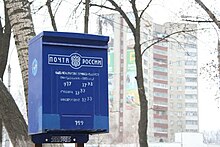
Since the soviet union dissolved, the Federal Postal Service consisted of a network of 90 disparate entities which were mainly listed as state institutions or federal state unitary enterprises. In legal terms, they were completely independent concerns. They were linked to the Federal Postal Network only by a trunk intrazonal and inter-district transmission and delivery system. The most ridiculous part of the whole system was that different parts of the same system connected by a single mechanism in adjacent regions were competing against each other, which mainly involved trying to lure big corporate clients away from the other competitors often at dumping prices. Also there were no uniform budgeting, planning or other processes. These companies operated using outdated and worn-out postal facilities representing about 50 different IT solutions in terms of industry technology. In accordance with the concept of restructuring the federal postal service, adopted by the Government Decree on 28 June 2002, the postal industry in the Russian Federation carried out the reorganization, aimed at creating a single, highly efficient and competitive company able to make a significant contribution to the solution of urgent problems on the accelerated development of the economy and resulted in the establishment of a single unified operator- Federal Unitary Enterprise Russian Post. By 2005 the reform was completed.
Post-reform period
[edit]In 2004 Elsag Datamat won the tender to build Russian Post’s first automated sorting center.[5] In 2008, Andrey Kazmin, former CEO of Sberbank was appointed to the CEO of the company.[6]
Although in January 2009 it was announced that Kazmin had to leave his post as CEO of the Russian Post.[7] Current General Director is Aleksandr Kiselyov.
Growing inefficiency in the 2010s
[edit]
The early 2010s saw a rise in complaints. The number of parcels from foreign online retailers had been rising steadily for several years and was certain to rise further.[8] According to Russian Post’s own estimates, orders from Internet shops are delivered to Russia mostly in ordinary or registered parcels; in 2009 there were 2.3 million, in 2012 the amount soared to 17 million. On March 6, 2012, five trucks from Germany were in queue to be unloaded at Vnukovo International Airport. At the International Post Office there had piled up 12,300 parcels, 5,300 EMS packages, and 36,000 minor incoming parcels. And two thousand parcels were waiting for customs clearance at Sheremetyevo International Airport.[9]
2012 saw the creating of a new resource called "anti-Russianpost.ru" emerged in the world web. The users highlight all instances of Russian Post’s bad work. In the middle of March the clients of on-line retailers launched a massive spam attack on the Moscow office of the Roskomnadzor watchdog. In this period the company received up to 1,000 messages from individuals with complaints about delayed deliveries of purchases made at Internet shops.
2013 collapse and reform
[edit]On March 2013 Russian Post reported the unfavorable state of affairs to the authorities of higher instance. In a special message Russian Post’s deputy general director, Nina Fetisova, told the Federal Communications Agency Rossvyaz and the Federal Customs Service the processing of international mail was in a critical situation at the customs posts Vnukovo and Sheremetyevo International Airport and also at the Central International Post Office in Moscow. The director of the federal postal services of the Vologda Oblast said "The reason for delays is not our own ineffectiveness, but the pressure of social factors. We have too many official functions: the delivery of pensions, of written correspondence, and the subscription to newspapers and magazines".
In order to improve the services, Prime Minister Dmitry Medvedev signed a Government Resolution to take the Russian Post out of the sphere of competence of the Federal Communications Agency Rossvyaz, and subordinated it directly to the Ministry of Communications and Mass Media.[9][10] Also, On April of that year, the General Director of the Post, Alexander Kiselyov was ousted from the office.[11]
The company's new management, in October 2013, stated an ambitious goal of doubling revenues to make the company ready for an initial public offering in 2018 by allowing it to provide banking services, reducing the number of unprofitable branches and focusing on providing deliveries from online retailers.[12]
In order to handle the growth of parcels, production capacity has been expanded regional seats of international postal exchange centers, with the company opening new international mail processing centers in Moscow at the Kazan station and in Yekaterinburg and Novosibirsk. In addition, Russian Post agreed with foreign postal operators sorting international mail delivery by region even in the country of the sender (pre-sorting began in China, the largest importer), which allows to reduce the delivery of international mail. For example, after opening Exchange center in Yekaterinburg, parcel from China to residents of the Sverdlovsk Oblast is delivered in five days, including all customs clearance.[13]
On August 2013 Russian Post had launched its first regional flight in the far eastern Russian republic of Yakutia. The company held a ceremony at Yakutsk Airport to launch its second new airmail plane under a programme to expand links to remote areas, its first being a flight in the Khabarovsk Krai territory on Russia’s east coast. Russian Post deputy director general Alexei Skatin said that "The mail must be delivered on time despite the difficult geography of the region. We are starting to improve the postal logistics in the remote regions of Russia".[14]
2014-2018 development program
[edit]In late October 2013 Prime Minister Dmitry Medvedev generally approved the Post's development program in a meeting with Minister of Communications Nikolai Nikiforov. Its goals are to turn the Russian Post from a model of "subsidized postal operator" to "self-sustaining postal business", modernization of its infrastructure and making its work more efficient. Logistics companies will create eight main hubs with automated sorting and direct exchange with each other. The service area of each hub will be about 700 km. In rural areas, there will be new formats of work: "postman plus internal transport" according to the reform. This will reduce the number of unprofitable offices from 14 thousand to about 8.5 thousand, most of which are in rural areas.[15] Also discussed in the draft is non-discriminatory access to the infrastructure of the postal service.[16]
2013 Law
[edit]On December 2013 the Russian government approved a draft law "On Postal Communication", and this was submitted to the State Duma. On approval of the government bill on Friday reported the press service of the Ministry of Communications and Mass Communications of the Russian Federation . The new law "On Postal Communication" includes a number of innovations aimed at the development of postal services market. The draft law approved new types of post offices: virtual, to provide postal services via the Internet, and Postomat, mobile and automated post offices. Citizens will be able to send e-mail messages according to the draft. The postal service itself will be divided the universal (sending mailings of all types and categories to any address at affordable rates) and courier (providing a limited set of postal services in a limited area).[17]
On December 2013 the Government sent its draft law for changing Federal Law "On Postal Communications" which is expected to be approved on Spring of 2014.[18] In that year Russian Post will begin deploying unified ERP system, set of integrated applications that allow a creation of a single environment to automate planning, accounting, control and analysis of all core business operations across the enterprise. The unified information system must work at the central office and at all branches of the Post.[19] The new law "On Postal Communication" includes a number of innovations aimed at the development of postal services market. The draft law approved new types of post offices: virtual, to provide postal services via the Internet, and Postomat, mobile and automated post offices. Citizens will be able to send e-mail messages according to the draft. The postal service itself will be divided the universal (sending mailings of all types and categories to any address at affordable rates) and courier (providing a limited set of postal services in a limited area). In late October 2013 Prime Minister Dmitry Medvedev generally approved the Post's development program in a meeting with Minister of Communications Nikolai Nikiforov. Among its goals are to turn the Russian Post from a model of "subsidized postal operator" to "self-sustaining postal business", modernization of its infrastructure and making its work more efficient. Also change logistics Companies will create eight main hubs with automated sorting and direct exchange with each other. Service area of each hub will be about 700 km. Number of branches in the cities will grow, while building new areas will be determined by regulations on their placement. In rural areas, there will be new formats of work: "postman plus internal transport" according to the reform. This will reduce the number of unprofitable offices from 14 thousand to about 8.5 thousand, most of whom are in rural areas.[20] Also discussed in the draft is non-discriminatory access to the infrastructure of the postal service.[21] On December 2013 the Government sent its draft law for changing Federal Law "On Postal Communications" which is expected to be approved on Spring of 2014. In that year Russian Post will begin deploying unified ERP system, set of integrated applications that allow you to create a single environment to automate planning, accounting, control and analysis of all core business operations across the enterprise. In September 2013 Deputy Minister of Communications Mikhail Evrayev said one of the major problems of the Russian Post is lack of a unified information system, which must work at the central office and all branches of the Post.[22]
Structure
[edit]
Russian Post includes:[23]
- central administrative apparatus, consisting of 22 units (Directorate departments, the Secretariat);
- 87 branches;
- 41,901 post office.
Enterprise branches are divided into 82 territorial control federal postal service and 5 specialized, which include:[23]
- The main center haul mail - FSUE "Russian Post";[23]
- EMS Russian Post;
- Automated sorting centers - branch office of Russian Post;
- Hybrid mail centers - branch office of FSUE Russian Post;
- Russian Post - FSUE Russian Post in Berlin.
The structure of branches are separate structural subdivisions, including post offices, department of transportation of mail, mainline and regional sorting centers.[23]
Operations
[edit]Russian Post offers all traditional mail services in its 42,000 offices. In addition it offers to cash payment cards, make utilities payments, execute cash transfers, receive and pay off consumer loans, purchase lottery, rail, flight and theater tickets as well as retail of various products including phone cards, envelops, postage stamps and more. On October 2012 the Russian Post had launched the SMS-notification for domestic shipments, and since December 2013 in a pilot program, Moscow clients of the Russian Post began receive free SMS-notification of passage of parcels from abroad. According to the press service of the postal operator, notice will inform the customer about the admission of international mail at the point of issuance and will complement the traditional paper notices. In the future, the Post plans to inform the customer via SMS about all stages of the passage of parcels including delivery in Russia, customs control, admission to point of delivery.[24]
Pochtomat
[edit]
In late 2010 a new delivery method with automated machines called Pochtomat (Russian: почтомат) which is combination of the words pochta, post in Russian and automat, came into use. In 2011 number of those postmats were deployed in Moscow and Saint Petersburg.[25] In April 2013 the first Pochtomat began working in Saransk[26] and in the summer of 2013 first pochtomat in the South Urals began to work in Chelyabinsk. Automatic issue of shipments made under a special code that the recipient receives a cell phone as an SMS. On receipt of the parcel or parcels given three days, after which the administration is transferred to the post office to deliver the traditional way. By June 2013, Russian Post operated 145 Pochtomat's in 60 cities.[27]
Financial services
[edit]On August 2013 Russian Post launched a service of paying loans of any Russian bank. Repayment of loan is a postal transfer to subdsidiary of the Post, ООО "Rapid", then the money is sent by bank transfer to the appropriate bank. Postal employees themselves fill pattern of payment by the customer, then the postal order form printed and signed by the customer. For the provision of postal services operator charges a fee of 1.90% with minimum of 50 rubles.[28]
Postal kiosks
[edit]In 2011 the Russian Post launched postal kiosks based on the results of the pilot project. In 2011 seven stalls of 6 square meter each. Besides sending and receiving regular and express mail, insurance and credit cards can be issued, repay loans, pay for cellular communication, Internet and utilities and purchase of railway and flight tickets. In September 2013 the Russian Post management decided to radically revise its approach to retail, and in particular refused to sell food in the offices, It was decided to expand the idea of postal kiosks, and even entered the draft of a new strategy of development of the Russian Post until 2023, which was prepared by Boston Consulting Group. In 2014 the Russian Post plans to open 10-15 new kiosks in Moscow and another 150 in other regions.[29]
Mobile post
[edit]Beginning in the 2010s Russian Post began using Mobile Post Van, also called "Post on Wheels" (Russian: Почта на колесах) which drive with driver and post seller into remote villages where the Post office was closed due to being ineffective (small rural communities), and provides all the post services that were once were in the post office.[30]
Regional sorting center
[edit]Russia's first automated regional sorting center opened in Podolsk, near Moscow in late 2009, using equipment of Italian Elsag Datamat SpA, it invested 55 million euros. In June 2011 another center was opened, in Saint Petersburg, which serves the Leningrad, Novgorod and Pskov Oblasts.[31]
International exchange points
[edit]Russian Post operates 13 points of customs clearance of postal items. Until 2013, the Moscow MMPO processed up to 80% of all incoming international shipments to Russia which created much stress on the Russian Post. In order to speed up the time for delivery of international parcels, the Russian Post opened two new international postal exchange points in Yekaterinburg and Novosibirsk. The latter one can process up to two thousand international EMS-daily departures, with an area more than 2,000 square meters. The Yekaterinburg Koltsovo international postal exchange point is the first international postal exchange in the Urals Federal District. It can handle up to 20,000 parcels and small packets per day in the 3,700m facility. Until the end of 2014 Russian Post expects to reduce the Moscow point of exchange share to 55%.[32][33] In addition there are exchange points in Bryansk, Samara, Orenburg, Petrozavodsk and Vladivostok.[34][35]
Foreign cooperation
[edit]In 2009, a first formal cooperation agreement came between the Russia and Italy to work together to develop the postal system in Russia. On late November 2013 Russian Post and Poste Italiane have signed a new agreement to cooperate further in order to improve the Russian postal system. The agreement, which was signed along with their technology supplier Selex, was sealed at a trade summit in Trieste during an official visit of Russian President Vladimir Putin, following up earlier agreements between the three companies. Along with development of e-commerce and international express mail services, the new agreement aims to develop hybrid mail in Russia for businesses, direct marketing and e-government services. This would allow mailers to send information electronically to be turned into physical mailpieces local to the recipient.[36]
Research
[edit]Research and Design Institute for postal services (Russian: Научно-исследовательский и проектно-конструкторский институт почтовой связи (ФГУП НИИПС)). It is Russia's only research organization specializing in solving problems of postal services industry. The company traces its history to 1960, when it was created by Special Design Bureau (SPKB), reorganized in 1991 as a Research and Design Institute for postal services. The institute's activities aimed at solving problems of development of postal services sector, improving efficiency and quality of functioning of postal services.
Main activities of the company:
- Development of concepts and programs for development of the sector of postal services;
- computerization of the industry;
- Development of specialized equipment, new technologies and techniques;
- Developing distance learning industry employees.
See also
[edit]- Media of Russia
- Ministry of Communications and Mass Media
- Postage stamps and postal history of Russia
- Rostelecom
- Russian post offices in China
- Russian post offices in Crete
- Russian post offices in the Turkish Empire
- Soviet and post-Soviet postage rates
- Telecommunications in Russia
- Transport in Russia
References
[edit]- ^ a b c "ДОСЬЕ: ФГУП "Почта России" /передается в связи с отставкой главы предприятия". TASS Telecom. July 18, 2013. Retrieved December 28, 2013.
- ^ "Based on addresses registry of Russian Federation". kontragent.info.
- ^ ""ЮТэйр" в 2014 г. в течение суток будет доставлять до адресата грузы "Почты России", объем отправлений составит 370 тонн в месяц". comnews.ru. Retrieved 14 December 2013.
- ^ "Moody's upgrades Sviaz-Bank (Russia) to B1/A1.ru from B2/Baa1.ru". cbonds.info. 2010-08-26. Retrieved 2010-10-04.
- ^ "Russian Post and Poste Italiane to develop joint e-commerce platform". Post & Parcel. Retrieved 30 November 2013.
- ^ "Appointment". Press Center: News. Russian Post. 2007-12-19. Retrieved 2008-01-06.
- ^ "Андрей Казьмин переводится с "Почты России"". Kommersant. 2009-01-12. Retrieved 2009-01-13.
- ^ "Почта России: во всем виновата таможня". tvrain.ru. Retrieved 10 April 2013.
- ^ a b "Slow-working Russian Post remains sitting duck for clients' anger". Itar Tass. Retrieved 10 April 2013.
- ^ "RF Government intervenes in the work of Russian post". Itar Tass. Retrieved 20 April 2013.
- ^ "Chief of Russian Post federal enterprise dismissed from office". Itar Tass. Retrieved 19 April 2013.
- ^ "Post Delivery Times Increasing". Moscow Times. Retrieved 22 November 2013.
- ^ ""Почте России" покой только снится. Объем зарубежных посылок в этом году удвоится". comnews.ru. Retrieved 22 November 2013.
- ^ "Postal Digest – Postal news from Canada, Israel, Russia, Brazil and Portugal". Post & Parcel. Retrieved 30 November 2013.
- ^ "Почтовая стратегия прошла чистилище". comnews.ru. Retrieved 30 November 2013.
- ^ "Правила недискриминационного доступа к инфраструктуре "Почты России" нуждаются в доработке". TASS Telecom. Retrieved 28 December 2013.
- ^ "Кабмин отошлет почту". comnews.ru. Retrieved 24 December 2013.
- ^ "Кабмин отошлет почту". comnews.ru. Retrieved 24 December 2013.
- ^ ""Почта России" в ближайшие полгода начнет внедрение системы автоматизации бизнес-процессов, затраты могут составить до $100 млн". TASS Telecom. Retrieved 28 December 2013.
- ^ "Почтовая стратегия прошла чистилище". comnews.ru. Retrieved 30 November 2013.
- ^ "Правила недискриминационного доступа к инфраструктуре "Почты России" нуждаются в доработке". TASS Telecom. Retrieved 28 December 2013.
- ^ ""Почта России" в ближайшие полгода начнет внедрение системы автоматизации бизнес-процессов, затраты могут составить до $100 млн". TASS Telecom. Retrieved 28 December 2013.
- ^ a b c d Подразделения аппарата управления
- ^ "Почта России" начинает уведомлять москвичей о поступлении международных посылок через SMS". TASS Telecom. Retrieved 28 December 2013.
- ^ ""Почта" спрячет посылки в терминалы". comnews.ru. Retrieved 7 December 2013.
- ^ "В центре Саранска появился первый почтомат". TASS Telecom. Retrieved 28 December 2013.
- ^ "В Челябинске появился первый "почтомат", всего по России их 145". TASS Telecom. Retrieved 28 December 2013.
- ^ ""Почта России" запустила услугу погашения банковских кредитов". TASS Telecom. Retrieved 28 December 2013.
- ^ ""Почта России" нашла малую форму. ФГУП откроет ларьки в бизнес-центрах". comnews.ru. Retrieved 21 December 2013.
- ^ ""Почта России" представила первую партию специально созданных для Сибири мобильных отделений". TASS-Telecom. Retrieved 2 January 2014.
- ^ ""Почта России" довела Петербург до автоматизации". comnews.ru. Retrieved 7 December 2013.
- ^ ""Почта России" разгрузит московский узел двумя новыми ММПО". comnews.ru. Retrieved 30 November 2013.
- ^ ""Почта России" открыла новые ММПО в Новосибирске и Екатеринбурге". comnews.ru. Retrieved 30 November 2013.
- ^ "Послать на 24 часа". comnews.ru. Retrieved 16 January 2014.
- ^ "комсвязи рассказало о достижениях в 2013 г." comnews.ru. 24 April 2014. Retrieved 26 April 2014.
- ^ "Russian Post and Poste Italiane to develop joint e-commerce platform". Post & Parcel. Retrieved 30 November 2013.
External links
[edit]- Official website (in English and Russian)
- Russian post eyes future IPO after reorganization
Category:Postal organisations Category:Communications in Russia Category:Companies of Russia Category:Companies of the Soviet Union Category:Postal system of Russia
Stamps of Russia
[edit]

Postage stamps of Russia have been issued since the time of printing and introduction of the first Russian stamps in 1857–1858. The first Soviet Russia stamp appeared in 1918. Eminent designers of Russian and Soviet postage stamps include Franz (Feodor) Kepler, Rihards Zariņš, Günther Reindorff, Ivan Dubasov, Ivan Shadr, Yury Artsimenev and others.[1][2][3] The Russian Federation has been issuing its stamps since 1992.
First stamps
[edit]The postage stamp idea had already swept much of the world when, in September 1856, the Russian authorities decided to follow suit.[4]
The first Russian postal stamp was designed by Franz Kepler and issued on 10 December 1857 by the circular of the Postal Department. The first stamps went on sale on 22 December [O.S. 10 December] 1857,[5] but officially people started to use stamps to pay internal correspondence on 1 January 1858.[1][4][6]
-
First Russian stamp, 1857, 10 kopecks
-
Tiflis stamp also known as Tiflis unique, 1857, 6 kopecks
In 1857, a local stamp was issued in Tiflis, Georgia, that was at that time a part of the Russian Empire. Known as Tiflis stamp or Tiflis unique, it is one of the rarest Russian stamps, with only three specimens being known.[7]
Later Russian Empire stamps
[edit]A 5-kopeck stamp for local postage appeared in 1863.[4] Its designer and engraver was F. M. Kepler[8] who continued to be a sole author of Russian stamps over few next decades. In the following year, a new common design of the Imperial definitive stamps, with the coat of arms in an oval, was introduced for 1-, 3- and 5-kopeck values.[4][9] These were used to make up complicated rates for international mail, which had previously required cash payments at the post office.[4]
-
Local post stamp of 1863,
5 kopecks -
4th definitive issue of 1864, with denominations of 1, 3, and 5 kopecks, no watermark
In September 1865, the Schlisselburgsky Uyezd (Shlisselburg district) became the first of the zemstvo offices to issue zemstvo stamps.[4][10]
-
Zemstvo stamp of Schlisselburgsky Uyezd, 5 kopecks
-
"EZGB" ([ЭЗГБ] Error: {{Langx}}: text has italic markup (help)) watermark introduced in 1866
After 1866, the stamps were printed on paper watermarked with a pattern of wavy lines, "EZGB"[a] letters[11] plus a set of more or less horizontal lines (13 for the height of the letters) and vertical lines running through the letters and halfway. Apart from that, the "grain" of the paper was always perpendicular to the watermark text. In the early years, the horizontal watermark prevailed, but for a minority of each value the grain was vertical. In later years, the vertical watermark prevailed. Contrary to common perception among collectors, there was no laid paper involved. The "stripes" were always part of the watermark.
The coat of arms design was changed in 1875, and used for 2- and 8-kopeck values,[12] and a 7-kopeck value in 1879. The 7-kopeck stamp was also printed on revenue stamp paper watermarked with a hexagon pattern; these are quite rare.[13]
-
7th definitive issue of 1875,
8 kopecks -
7th definitive issue of 1875, 8 kopecks, with plate error of the broken post horn
-
8th definitive issue of 1879,
7 kopecks
A new issue of 14 December 1883 featured an updated design, lower values printed in a single colour, and new high values of 14, 35, and 70 kopecks. January 1884 saw the introduction of 3.50- and 7-ruble stamps, physically much larger than existing stamps.[14]
- Examples of the 9th definitive issue stamps
-
1883, 7 kopecks
-
1884, 14 kopecks, imperforate
-
Two rare stamps of 1884, 3.50 and 7 rubles
In 1889, the designs (made by Kepler and Nabokov) were changed again, this time to introduce thunderbolts across the posthorns underneath the double-headed eagle,[15] and in printings after 1902 the usual grain of the paper was changed to be vertical.[16]
-
11th definitive issue of 1889, 1 kopeck
-
A very rare stamp of the Russian post offices in the Ottoman Empire, 1863, 6 kopecks
Some of the Russian stamps were highly valued by collectors in the 19th century. For instance, a 6-kopeck stamp for international correspondence issued in 1863 was estimated at 100 DM.[2] The stamp remains extremely rare, with two or three examples being recorded.
At the end of 1904, Russia issued its first semi-postal stamps. The four values were each sold at 3 kopecks over face to provide for orphans of casualties in the Russo-Japanese War.[4] The first stamp of the series was designed by E. Frank and the three others by R. Zariņš.[17]

5+3 kopecks, Monument to Minin and Pozharsky, the leaders of the all-Russian volunteer army in 1611–12 (Moscow, 1818);
7+3 kopecks, Monument to Peter the Great (Bronze Horseman, St. Petersburg, 1782);
10+3 kopecks, Moscow Kremlin
In 1908, a new series designed by Rihards Zariņš came out, using a mix of old and new designs, all printed on unwatermarked wove paper, and with lozenges on the face to discourage postage stamp reuse. The 7-kopeck stamp from this series had a very rare variety known as Three pearls; 15–20 specimens may exist.[18]
- Examples of the 17th definitive issue of 1909
-
4 kopecks
-
10 kopecks
-
7 kopecks, with rare "Three pears" design
Russia's first series of commemorative stamps appeared on 2 January 1913 to mark the 300th anniversary of the Romanov dynasty. The 17 stamps featured portraits of the various Tsars, as well as views of the Kremlin, Winter Palace, and House of the Boyars Romanov.[4] They were designed by the prominent artists Ivan Bilibin, Rihards Zariņš, and Eugene Lanceray. The stamp engravers were Pericles Ksidias, F. Lundine, and Ferdinand Schirnböck.[19]

2 kopecks, Alexander II (after the engraving of Academician Lavrentiy Seryakov, from the portrait of Georg von Bothmann, 1873);
3 kopecks, Alexander III (after the photo of Sergey Levitsky);
4 kopecks, Peter I (after the portrait of Godfrey Kneller, 1698);
7 & 10 kopecks, & 5 rubles, Nicholas II (after photo);
14 kopecks, Catherine II (after the sculptural bas-relief portrait by Marie-Anne Collot, 1780s);
15 kopecks, Nicholas I (after the portrait of Franz Krüger, 1850);
20 kopecks, Alexander I (after the portrait of George Dawe);
25 kopecks, Aleksey Mikhailovich (after the engraving from the handwritten book Bolshoy Moskovsky Titulyarnik, 1672);
35 kopecks, Paul I (after the portrait of Jean-Louis Voille, 1791);
50 kopecks, Elizabeth Petrovna (after the portrait of Louis Tocqué, 1756);
70 kopecks, Mikhail Feodorovich (after the engraving from the handwritten book Bolshoy Moskovsky Titulyarnik, 1672);
1 ruble, Moscow Kremlin (after photo); 2 rubles, Winter Palace in St. Petersburg (architect Bartolomeo Rastrelli, after a photo);
3 rubles, House of the Boyars Romanov in Zaryadye in Moscow (builder Meletius Alekseyev, 1565–67, after a photo)

In 1915 and 1916, as the government disintegrated under the pressures of World War I, several of the 1913 Romanov designs were printed on card stock and used as paper money.[4][20][21]
- Examples of the two-sided postal currency stamp issue of 1915–16
-
Alexander I, 20 kopecks, and Alexander III, 3 kopecks
-
Nicholas I, 15 kopecks
In 1916 and 1917, the 7- and 14-kopeck definitive stamps were also surcharged 10 and 20 kopecks due to shortages.[4][22]
Revolution and Civil War period
[edit]Provisional Government
[edit]In 1917, the Russian Provisional Government reprinted the old Tsarist designs, but sold them imperforate.[4][23]
- Examples of the Provisional Government definitive issue of 1917
-
2 kopecks
-
1 ruble
RSFSR
[edit]The first stamps of the Russian Soviet Federative Socialist Republic (RSFSR) appeared in 1918, as two values designed by Rihards Zariņš and depicting a sword breaking a chain. While great quantities of these stamps survive, they saw little use, and used copies are worth more than mint.[1][4][5][24]

In the years of the Civil War, postage stamps served as a kind of currency in a number of regions. During the later famine, stamps were used as a means of exchange for products. The Pravda newspaper issue of 9 March 1922 "urged the population “not to throw away stamps” and called on all citizens and children of the RSFSR to gather and send all canceled stamps, stamp collections, and anything they had on hand to be exchanged for chocolate and other products for starving children."[25]
-
1921 Pomgol famine relief semi-postal, 2,250 rubles
-
1922 famine relief semi-postal,
100+100 rubles -
1922 famine relief semi-postal,
250+250 rubles -
Russian Empire stamp overprinted ″Philately for Children″, 1922
-
1922 famine relief semi-postal issue, non-denominated but sold at 25 rubles each. Designed by R. Zariņš
After coming to power, the Soviet authorities were positively minded towards using philately for propagandistic purpose. Philately was considered one more way to popularise the first socialist state and the October Revolution. The propaganda content of Soviet Russia stamps was a vast subject as reflected in new definitive issues since 1921.[25]
The next RSFSR postage stamps appeared in August 1921, after inflation had taken hold. The set's designers were V. Kupriyanov, G. Reindorff and M. Antonov. Its values ranged from 1 to 1000 rubles.[26]
- Stamp design examples of the RSFSR 1st defenitive issue, 1921
-
Symbols of agricultural labour,
1 ruble. Designed by V. Kupriyanov -
"Hammer and sickle" symbol,
20 rubles. Designed by
V. Kupriyanov -
"Proletarian Freed" ("Russia New Triumphant" or "The Dragon Slayer"),
40 rubles. Designed by M. Antonov -
Symbols of science and arts, 250 rubles. Designed by G. Reindorff
-
Symbols of industrial labour, 1000 rubles. Designed by
G. Reindorff
By the next year these stamps were being surcharged in various ways, with face values of up to 100,000 rubles.[4][27]
- Examples of 1921 stamps surcharged in 1922
-
1-ruble stamp surcharged to
5,000 rubles -
40-ruble stamp surcharged to 10,000 rubles
-
250-ruble stamp surcharged to
7,500 rubles
One stamp of the 3rd definitive series of 1922, 7,500-ruble blue with horizontal watermark, has a very rare gutter tête-bêche block of four. Known as R.S.F.S.R. Definitives tête-bêche block, it is possibly unique.[28][29] There is also a rare 50-kopeck Russian consular tax stamp of 1922, Consular poltinnik, with "Air Post" and 1,200 DM overprint and estimated 50–75 specimens in existence. Especially rare is overprint type IV that occured only twice per setting of 25, hence only four can exist.
- RSFSR rare stamps of 1922
-
Tête-bêche block of 7,500-ruble definitive stamps
-
Consular tax stamp known as Consular poltinnik
A currency reform in 1922 that exchanged money at a 10,000-to-1 rate enabled new postage stamps in the 5- to 200-ruble range, including a set marking the 5th anniversary of the October Revolution (designed by Ivan Dubasov), and Tsarist stamps surcharged with a five-pointed star containing a hammer and sickle.[4][30]
- Examples of the RSFSR 1922 stamps
-
5th anniversary of the October Revolution,
5 rubles -
5-ruble surcharge on
20-kopeck stamp -
20-ruble surcharge on
15-kopeck stamp
Stamps with portraits of a worker, peasant and soldier (including a very rare 70r Red Army Soldier error) also appeared this year;[4][31] variations on these portrait designs made by Ivan Shadr, A. Yakimchenko and A. Troitsky, including the Gold Standard issue, would continue to be issued throughout the 1920s.[4]
- Examples of the RSFSR 4th definitive issue stamps
-
Worker, 10 rubles, imperforate, 1922
-
Red Army soldier, 100 rubles, imperforate, 1922
-
Peasant, 5 rubles, perforated, 1923
Other stamp issuers
[edit]
The period of the Russian Revolution and the subsequent Civil War is complicated philatelically; post offices across the country were thrown on their own devices, and a number of the factions and breakaway republics issued new kinds of stamps, although in some cases they seem to have been as much for publicity purposes, few genuine uses having been recorded.
Entities issuing their own stamps, among others, include:
Finnish occupation of Aunus
[edit]At 1919–1921, there was Aunus expedition where a group of Finnish volunteers occupied parts of East Karelia (Finnish: Aunus, Russian: Олонецкая Карелия, which is Olonets Karelia). There were stamps issued for Aunus troops by local authorities. They were Finnish definitives from 1917 with overprint Aunus.
Soviet Union
[edit]Postage stamps of the USSR were issued in the period 1923 to 1991.[5] They bore a specific inscription in Russian: "Почта СССР" ("Post of the USSR"). The thematics of Soviet stamps mirrored to a large extent the history, politics, economics and culture of this world's first socialist state.
-
Lenin Mourning issue stamp of 1924. Designed by Ivan Dubasov
-
75th birth anniversary of Joseph Stalin, 1954
-
Nikita Khrushchev's visit to the USA on 15 September 1959
-
USSR stamp celebrating election of the first Russian Federation President Boris Eltsin
in 1991
Russian Federation
[edit]The first Russian Federation issue appeared on 10 January 1992. It was a series of three stamps dedicated to the XVI Olympic Winter Games in Albertville.[5] The stamp designer Yuri Artsimenev portrayed winter sports such as Nordic combined, freestyle skiing, and bobsledding. In February 1992, the first issue of definitive Russian Federation stamps in denominations of 20 and 30 kopecks came into circulation. They depicted Saint George and the Millennium of Russia monument.
-
First Russian Federation issue of 1992, XVI Olympic Winter Games in Alberville
-
First definitive stamp of the Russian Federation depicting Saint George, 1992
The first souvenir sheet was produced in January 1992 and was dedicated to the protection of nature. The first commemorative issue was produced in February 1992; it was a souvenir sheet dedicated to the 750th anniversary of the Battle on the Ice.
- 1992 miniature sheets of the Russian Federation
-
First miniature sheet "Protection of Nature is a Vital Topic in Philately"
-
First commemorative issue marking the 750th anniversary
of the Battle on the Ice
In addition to historical dates, Russian stamp issues commemorate such important contemporary political events as presidential election and inauguration.
-
Vladimir Putin election in 2000
-
Dmitry Medvedev election in 2008
-
Vladimir Putin inauguration in 2012
There have also been unusual Russian stamp issues. In February 2003, after the victory of Russian tennis players who won 2002 Davis Cup for the first time in the history of the competition, a souvenir sheet was issued. The Davis Cup image was made with embossed silver (99.9%). The sheet margins showed the tennis court in the Palais Omnisports de Paris-Bercy. Crushed genuine soil from the court was applied on the image using thermography.[32]

In August 2003, the Russian Post released a series of five flavoured stamps "Gifts of Nature". There were pineapple, pear, melon, strawberries, and apple on the stamps portrayed by the artist Peter Zhilichkin. For each image, the appropriate flavour was picked up, which was incorporated into stamp gum. In addition and for the first time in the contemporary history of the Russian stamps, all stamps of the series were made round.[33]
- Gifts of Nature issue of flavoured round stamps, 2003
-
Pineapple
-
Pear
-
Melon
-
Strawberries
-
Apple
There were several issues within the Sochi 2014 philatelic programme. In November 2013, the Russian Post issued the New Year stamps depicting mascots of the upcoming 2014 Winter Olympics and Paralympics. The stamps bearing the images of the Leopard, Polar Bear, Hare, Snowflake and Ray of Light, with a fabulous winter scenery in the background, appeared in all post offices of Russia. Face value of each stamp was 20 rubles, and circulation was of 680,000 copies.[34]
- Mascots of 2014 Winter Olympics and Paralympics issue of 2013
-
Leopard
-
Polar Bear
-
Hare
-
Snowflake and Ray of Light
- Olympics and Paralympics Mascots miniature sheets of 2012
-
Leopard, Polar Bear, and Hare
See also
[edit]- 70r Red Army Soldier error
- A.S. Popov Central Museum of Communications
- British Society of Russian Philately
- Definitive stamps of Russia
- Definitive stamps of the Soviet Union
- First stamp of the Russian Empire
- First USSR stamps
- Gold Standard issue
- International trading tax stamp
- Joint issue
- List of people on stamps of Russia
- List of postage stamps
- Postage stamps and postal history of the Far Eastern Republic
- Postage stamps and postal history of Karelia
- Postage stamps and postal history of Tannu Tuva
- Postal history of Russia
- Rossica Society of Russian Philately
- Russian philatelic forgeries
- Russian Post
- Russian post offices abroad
- Soviet and post-Soviet postage rates
- Soviet Union stamp catalogue
- Stamps of the Soviet Union
- Zemstvo stamp
Notes
[edit]- ^ ЭЗГБ in Cyrillic, which is short for Russian: Экспедиция заготовления государственных бумаг. Currently, this is the Federal State Unitary Enterprise "Goznak".
References
[edit]- ^ a b c Владинец, Н. И. [Vladinets, N. I.] (1975). "Почтовые марки" [Postage stamp]. In Прохоров, А. М., гл. ред. (ed.). Большая советская энциклопедия: в 30 т. (1970–1979) [The Great Soviet Encyclopedia] (in Russian; English translation). Vol. 20 (Плата – Проб) (3rd ed.). М. [Moscow]: Советская энциклопедия [Soviet Encyclopedia]. Retrieved 2015-06-21.
{{cite book}}: CS1 maint: multiple names: authors list (link) CS1 maint: unrecognized language (link) - ^ a b Ivanova, V. (2015-02-20). "Philately in Russia, Part 1. Philately in the Russian Empire". Russia-IC: Culture & Arts: Manners, Customs and Traditions. Russia-InfoCentre; Guarant-InfoCentre. Archived from the original on 2015-06-21. Retrieved 2015-06-21.
- ^ a b c d e f g h i j k l m n o p Oliver A. (2007). Russian Postage Rates: A chronological listing (PDF). [Alan Oliver]. Archived from the original (PDF) on 2015-05-29. Retrieved 2015-05-29.
- ^ a b c d "December, 22 in history". RT projects: Russiapedia: On this day: Russia in a click. Moscow: RT.com; Autonomous Nonprofit Organization “TV-Novosti”, Channel “RT TV”. Archived from the original on 2015-06-26. Retrieved 2015-06-26.
- ^ "Stamps of the Russian Empire (1721–1917): 1857. December. – 1858. March. The first standard issue. (The first nation-wide issue)". Philately: Catalog. Post stamps. Russian Empire. USSR. Scandinavian Catalog; skandinav.eu. Archived from the original on 2015-06-24. Retrieved 2015-06-24.
- ^ "City mail (1857, 1863): Postage stamps of Georgia. First Georgian postage stamp. 1857. June. Local issue for the Tiflis city post". Philately: Catalog. Post stamps. Russian Empire. USSR. Scandinavian Catalog; skandinav.eu. Archived from the original on 2015-06-25. Retrieved 2015-06-25.
- ^ "City mail (1857, 1863): 1863. August. The state issue for the City post of Saint Petersburg and Moscow". Philately: Catalog. Post stamps. Russian Empire. USSR. Scandinavian Catalog; skandinav.eu. Archived from the original on 2015-06-24. Retrieved 2015-06-24.
- ^ "Stamps of the Russian Empire (1721–1917): 1864. July. The third standard issue. (The third nation-wide issue)". Philately: Catalog. Post stamps. Russian Empire. USSR. Scandinavian Catalog; skandinav.eu. Archived from the original on 2015-06-24. Retrieved 2015-06-24.
- ^ "Russia Zemstvos". Stamps, perfins, revenues from Russia and Hungary, lighthouses and whiskylabels. The Netherlands: Jan Langenberg; InterNLnet. Archived from the original on 2012-07-30. Retrieved 2007-08-14.
(Taken from the catalogue by Feodor Chuchin).
- ^ "Stamps of the Russian Empire (1721–1917): 1866. August. The fifth standard issue. (The fifth nation-wide issue)". Philately: Catalog. Post stamps. Russian Empire. USSR. Scandinavian Catalog; skandinav.eu. Archived from the original on 2015-06-24. Retrieved 2015-06-24.
- ^ "Stamps of the Russian Empire (1721–1917): 1875. June18 – July. The seventh standard issue. (The seventh nation-wide issue)". Philately: Catalog. Post stamps. Russian Empire. USSR. Scandinavian Catalog; skandinav.eu. Archived from the original on 2015-06-24. Retrieved 2015-06-24.
- ^ "Stamps of the Russian Empire (1721–1917): 1879. March 19. The eighth standard issue. (The eighth nation-wide issue)". Philately: Catalog. Post stamps. Russian Empire. USSR. Scandinavian Catalog; skandinav.eu. Archived from the original on 2015-06-24. Retrieved 2015-06-24.
- ^ "Stamps of the Russian Empire (1721–1917): 1884. 25 January – 1888. March. The ninth standard issue. (The ninth nation-wide issue)". Philately: Catalog. Post stamps. Russian Empire. USSR. Scandinavian Catalog; skandinav.eu. Archived from the original on 2015-06-24. Retrieved 2015-06-24.
- ^ "Stamps of the Russian Empire (1721–1917): 1889. May. The eleventh standard issue. (The eleventh nation-wide issue)". Philately: Catalog. Post stamps. Russian Empire. USSR. Scandinavian Catalog; skandinav.eu. Archived from the original on 2015-06-24. Retrieved 2015-06-24.
- ^ "Stamps of the Russian Empire (1721–1917): 1902–04. The thirteenth standard issue. (The thirteenth nation-wide issue)". Philately: Catalog. Post stamps. Russian Empire. USSR. Scandinavian Catalog; skandinav.eu. Archived from the original on 2015-06-24. Retrieved 2015-06-24.
- ^ "Stamps of the Russian Empire (1721–1917): 1904. December. In favor of orphans of soldiers of field army. (The sixteenth nation-wide issue)". Philately: Catalog. Post stamps. Russian Empire. USSR. Scandinavian Catalog; skandinav.eu. Archived from the original on 2015-06-24. Retrieved 2015-06-24.
- ^ "Stamps of the Russian Empire (1721–1917): 1908. December. – 1917. The eighteenth standard issue. (The nineteenth nation-wide issue)". Philately: Catalog. Post stamps. Russian Empire. USSR. Scandinavian Catalog; skandinav.eu. Archived from the original on 2015-06-24. Retrieved 2015-06-24.
- ^ "Stamps of the Russian Empire (1721–1917): 1913. January. The 300th Anniversary of the Romanovs Dynasty. The twentieth nation-wide issue)". Philately: Catalog. Post stamps. Russian Empire. USSR. Scandinavian Catalog; skandinav.eu. Archived from the original on 2015-06-25. Retrieved 2015-06-25.
- ^ "Stamps of the Russian Empire (1721–1917): 1915. October. Currency stamps. First issue". Philately: Catalog. Post stamps. Russian Empire. USSR. Scandinavian Catalog; skandinav.eu. Archived from the original on 2015-06-25. Retrieved 2015-06-25.
- ^ "Stamps of the Russian Empire (1721–1917): 1916. Currency stamps. Second issue; 1916. Currency stamps. Third issue". Philately: Catalog. Post stamps. Russian Empire. USSR. Scandinavian Catalog; skandinav.eu. Archived from the original on 2015-06-25. Retrieved 2015-06-25.
- ^ "Stamps of the Russian Empire (1721–1917): 1916. September 10 – 1917. January 1. The twentieth (auxiliary) issue. (The twenty fourth nation-wide issue)". Philately: Catalog. Post stamps. Russian Empire. USSR. Scandinavian Catalog; skandinav.eu. Archived from the original on 2015-06-25. Retrieved 2015-06-25.
- ^ "Republic Russia stamps (1917). The stamps issued in circulation after February Revolution of 1917: 1917. March. The twenty first standard issue. (The twenty fifth nation-wide issue)". Philately: Catalog. Post stamps. Russian Empire. USSR. Scandinavian Catalog; skandinav.eu. Archived from the original on 2015-06-25. Retrieved 2015-06-25.
- ^ "Stamps of the RSFSR (1917–1991): 1918. November 7 (October 25). The first revolutionary issue of stamps of RSFSR". Philately: Catalog. Post stamps. Russian Empire. USSR. Scandinavian Catalog; skandinav.eu. Archived from the original on 2015-06-25. Retrieved 2015-06-25.
- ^ a b Grant, J. (July 1995). "The socialist construction of philately in the early Soviet era". Comparative Studies in Society and History. 37 (3): 476–493. doi:10.1017/S0010417500019770. ISSN 0010-4175. JSTOR 179216. S2CID 143458562. Retrieved 2015-05-15. Archived from the original and another source on 2015-05-15.
- ^ "Stamps of the RSFSR (1917–1991): 1921. August. The first standard issue of stamps of RSFSR". Philately: Catalog. Post stamps. Russian Empire. USSR. Scandinavian Catalog; skandinav.eu. Archived from the original on 2015-06-25. Retrieved 2015-06-25.
- ^ "Stamps of the RSFSR (1917–1991): 1922. February. Auxiliary standard issue; 1922. March; 1922. November". Philately: Catalog. Post stamps. Russian Empire. USSR. Scandinavian Catalog; skandinav.eu. Archived from the original on 2015-06-25. Retrieved 2015-06-25.
- ^ "Stamps of the RSFSR (1917–1991): 1922. March – April. The second standard issue". Philately: Catalog. Post stamps. Russian Empire. USSR. Scandinavian Catalog; skandinav.eu. Archived from the original on 2015-06-25. Retrieved 2015-06-25.
- ^ "Lot No. 3208". Past auctions and realizations: R.S.F.S.R. Definitives – March 4, 1922. New York: Cherrystone Auctions. February 2014. Archived from the original on 2015-06-25. Retrieved 2015-06-25.
- ^ "Stamps of the RSFSR (1917–1991): 1922. November. To the 5 anniversary of October Revolution; 1922. December – 1923. March". Philately: Catalog. Post stamps. Russian Empire. USSR. Scandinavian Catalog; skandinav.eu. Archived from the original on 2015-06-25. Retrieved 2015-06-25.
- ^ "Stamps of the RSFSR (1917–1991): 1922. December – 1923. January. Third standard issue". Philately: Catalog. Post stamps. Russian Empire. USSR. Scandinavian Catalog; skandinav.eu. Archived from the original on 2015-06-25. Retrieved 2015-06-25.
- ^ "Каталог России" [Catalogue of Russia]. Филателия [Filateliya] (in Russian). 38 (4). М. [Moscow]: Federal State Unitary Enterprise Publishing and Trading Centre “Marka”: 1. April 2003. ISSN 0860-4478.
{{cite journal}}: Check|issn=value (help) - ^ Жукова, И. [Zhukova, I.] (November 2003). ""Душистые дары природы"" [Fragrant Gifts of Nature]. Филателия [Filateliya] (in Russian). 38 (11). М. [Moscow]: Federal State Unitary Enterprise Publishing and Trading Centre “Marka”: 1. ISSN 0860-4478.
{{cite journal}}: Check|issn=value (help)CS1 maint: multiple names: authors list (link) - ^ "В почтовое обращение вышли новогодние марки с изображением талисманов Олимпийских и Паралимпийских игр-2014 в Сочи" [Into circulation came out New Year stamps depicting the mascots of the Olympic and Paralympic Games 2014 in Sochi]. Новости: Архив за 2013 год [News: Archive of 2013] (in Russian). Псков [Pskov}: УФПС Псковской области – филиал ФГУП «Почта России»; Министерство связи и массовых коммуникаций РФ, Северо-Западный Федеральный округ [Directorate of the Federal Postal Service in Pskov Oblast – Federal State Unitary Enterprise "Russian Post" Branch; Ministry of Communications and Mass Media of Russia, Northwestern Federal District]. 2013-12-02. Archived from the original on 2015-06-22. Retrieved 2015-06-22.
External links
[edit] Media related to Michael Romanov/sandbox at Wikimedia Commons
Media related to Michael Romanov/sandbox at Wikimedia Commons- Leach, J. "Russia". A–Z of postal authorities. Encyclopaedia of Postal History. Stampsite: The Encyclopaedia of Postal Authorities; John Leach. Archived from the original on 2012-10-10. Retrieved 2006-08-15.
- Rossiter, S. "Russia". Stamp Atlas. Sandafayre Stamp Auctions. Archived from the original on 2013-10-15. Retrieved 2015-06-26.
{{cite web}}: Unknown parameter|coauthors=ignored (|author=suggested) (help) - "Stamps, perfins, revenues from Russia and Hungary". The Netherlands: Jan Langenberg. Archived from the original on 2015-06-26. Retrieved 2015-06-26.
- "2. Марки Большой России [Stamps of the Great Russia]". Библиотека ИЦ [IC Library (2,200+ articles & references)] (in Russian). Информационный Центр "Россия и Мир" [Information Center "Russia and World"]. Archived from the original on 2015-06-26. Retrieved 2015-06-26.
- "5. Фальсификаты [Fakes & Forgeries]". Библиотека ИЦ [IC Library (2,200+ articles & references)] (in Russian). Информационный Центр "Россия и Мир" [Information Center "Russia and World"]. Archived from the original on 2015-06-26. Retrieved 2015-06-26.
- "6. Фантастические и спекулятивные выпуски [Fantasy & Cinderella stamps]". Библиотека ИЦ [IC Library (2,200+ articles & references)] (in Russian). Информационный Центр "Россия и Мир" [Information Center "Russia and World"]. Archived from the original on 2015-06-26. Retrieved 2015-06-26.
Category:Lists of postage stamps Category:1857 introductions



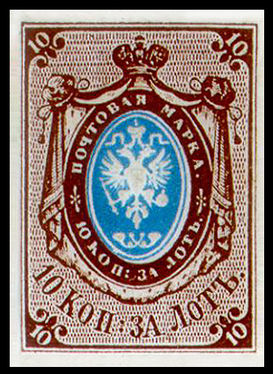

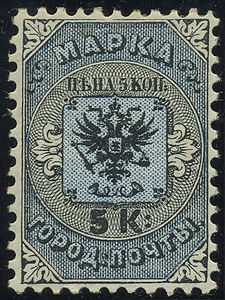


!["EZGB" ([ЭЗГБ] Error: {{Langx}}: text has italic markup (help)) watermark introduced in 1866](http://upload.wikimedia.org/wikipedia/commons/thumb/4/45/10-%D0%9F%D1%80%D0%BE%D0%B1%D0%BD%D1%8B%D0%B9_%D0%B2%D1%8B%D0%BF%D1%83%D1%81%D0%BA_%D0%9F%D1%81%D0%BA%D0%BE%D0%B2%D1%81%D0%BA%D0%B8%D1%85_%D0%BF%D1%80%D0%BE%D0%B2%D0%B8%D0%B7%D0%BE%D1%80%D0%B8%D0%B9.png/243px-10-%D0%9F%D1%80%D0%BE%D0%B1%D0%BD%D1%8B%D0%B9_%D0%B2%D1%8B%D0%BF%D1%83%D1%81%D0%BA_%D0%9F%D1%81%D0%BA%D0%BE%D0%B2%D1%81%D0%BA%D0%B8%D1%85_%D0%BF%D1%80%D0%BE%D0%B2%D0%B8%D0%B7%D0%BE%D1%80%D0%B8%D0%B9.png)

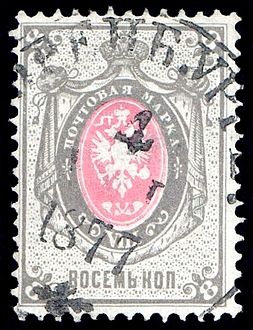
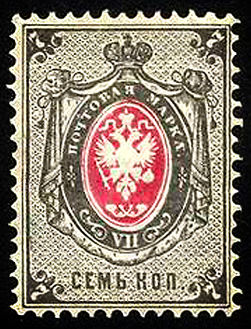
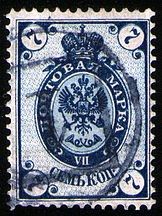
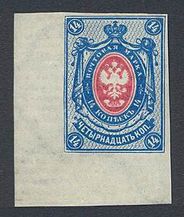


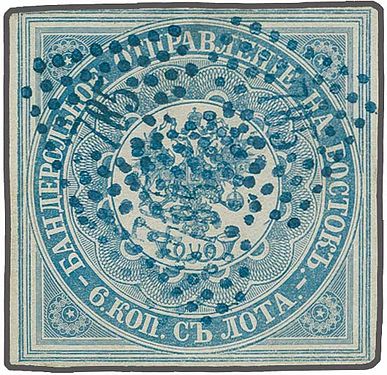


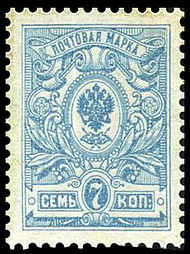


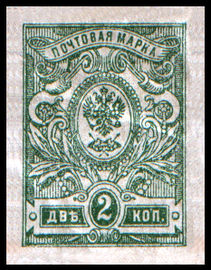
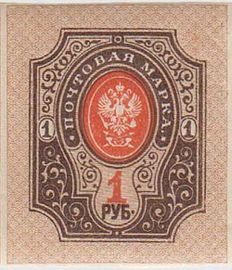







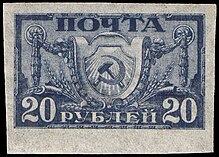
!["Proletarian Freed [Wikidata; Reasonator]" ("Russia New Triumphant" or "The Dragon Slayer"), 40 rubles. Designed by M. Antonov](http://upload.wikimedia.org/wikipedia/commons/thumb/6/68/1921_CPA_7.jpg/244px-1921_CPA_7.jpg)
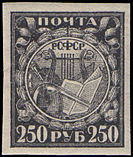

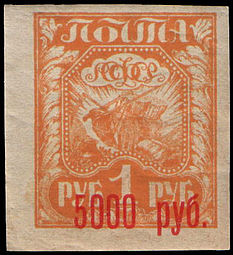


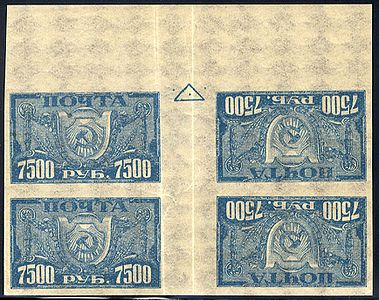
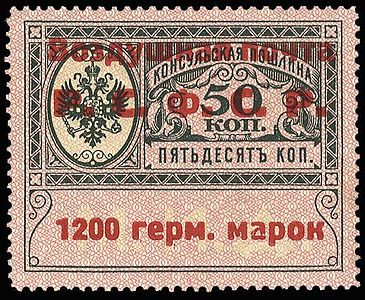




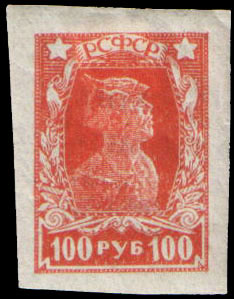
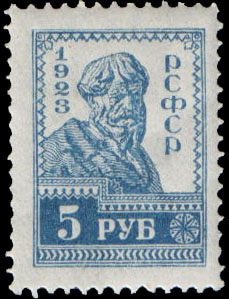



![Lenin Mourning issue [Wikidata; Reasonator] stamp of 1924. Designed by Ivan Dubasov](http://upload.wikimedia.org/wikipedia/commons/thumb/b/b8/Stamp_Soviet_Union_1924_199.jpg/208px-Stamp_Soviet_Union_1924_199.jpg)





